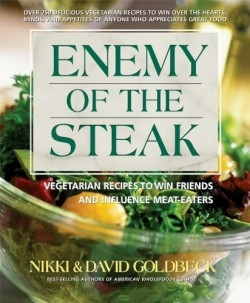Enemy of the Steak
Vegetarian Recipes to Win Friends and Influence Meat-Eaters
Though a lot has changed since 1973 when Nikki and David Goldbeck first became well-known with the publication of The Supermarket Handbook, and “vegetarian” may no longer be a dirty word, meat remains the star on our plates. The Goldbecks, who have co-authored eight books, including Tastemaker Award-nominated American Wholefoods Cuisine, still have plenty to write about.
Enemy of the Steak is a comprehensive and delectable tour of tasty meals which anyone can make at home. All of the recipes are straightforward with relatively few ingredients and no frou frou chef techniques. Only a few of the ingredients, such as quinoa, a nutrient-rich grain, will be exotic to the veggie-novice.
The eleven chapters cover every course, including breakfast, hors d’oeuvres, and dessert. Before launching into the recipes, the Introduction, “Stocking the Pantry,” and “Basic Training” chapters provide a very thorough primer on why eating vegetables is a good idea, what one should have on hand to easily make the recipes, and useful kitchen techniques, such as slashing cooking times with a pressure cooker. The approach is geared towards the veggie-curious of average kitchen skill who crave wholesome home cooking.
While it is clear that tastiness is important to the recipes, their balanced nutritional value is paramount. The focus is on whole foods which are nutrient-dense. Milk, butter, and sugar never come into play. The Goldbecks rely on vegetable combinations, or suggest combining several dishes in a meal, to round out the protein and other nutritional requirements. In perusing this book, one notices how many cherished traditional recipes are vegetarian by nature, and how wide the range of choices. In over two hundred and fifty recipes, they cover everything imaginable, from Orange Griddlecakes, to Yogurt Cucumber Salad, to White Bean Ratatouille, to Brownies. Even in the more unusual recipes, the Goldbecks’ informative and kind approach entices. For example, the introduction to Orange Arame Salad reads, “Arame is a shredded, dark brown sea grass with a mild aroma and flavor. It is a good introduction to sea vegetables, as it tastes least strongly of the sea.”
One helpful aspect missing in this very thorough book is illustrations or photographs of the finished meals. Occasionally, a pencil drawing of a vegetable graces the page. However, especially for someone who may not be familiar with vegetarian cuisine, a few images would go a long way. Regardless, this book is an excellent guide for alternatives to getting dinner on the table in fresh and inventive ways. Those seeking a low-fat diet, or with allergies to dairy or wheat, will also find much to munch. So drop that pork chop and take a peek.
Reviewed by
Naomi Millán
Disclosure: This article is not an endorsement, but a review. The publisher of this book provided free copies of the book to have their book reviewed by a professional reviewer. No fee was paid by the publisher for this review. Foreword Reviews only recommends books that we love. Foreword Magazine, Inc. is disclosing this in accordance with the Federal Trade Commission’s 16 CFR, Part 255.

